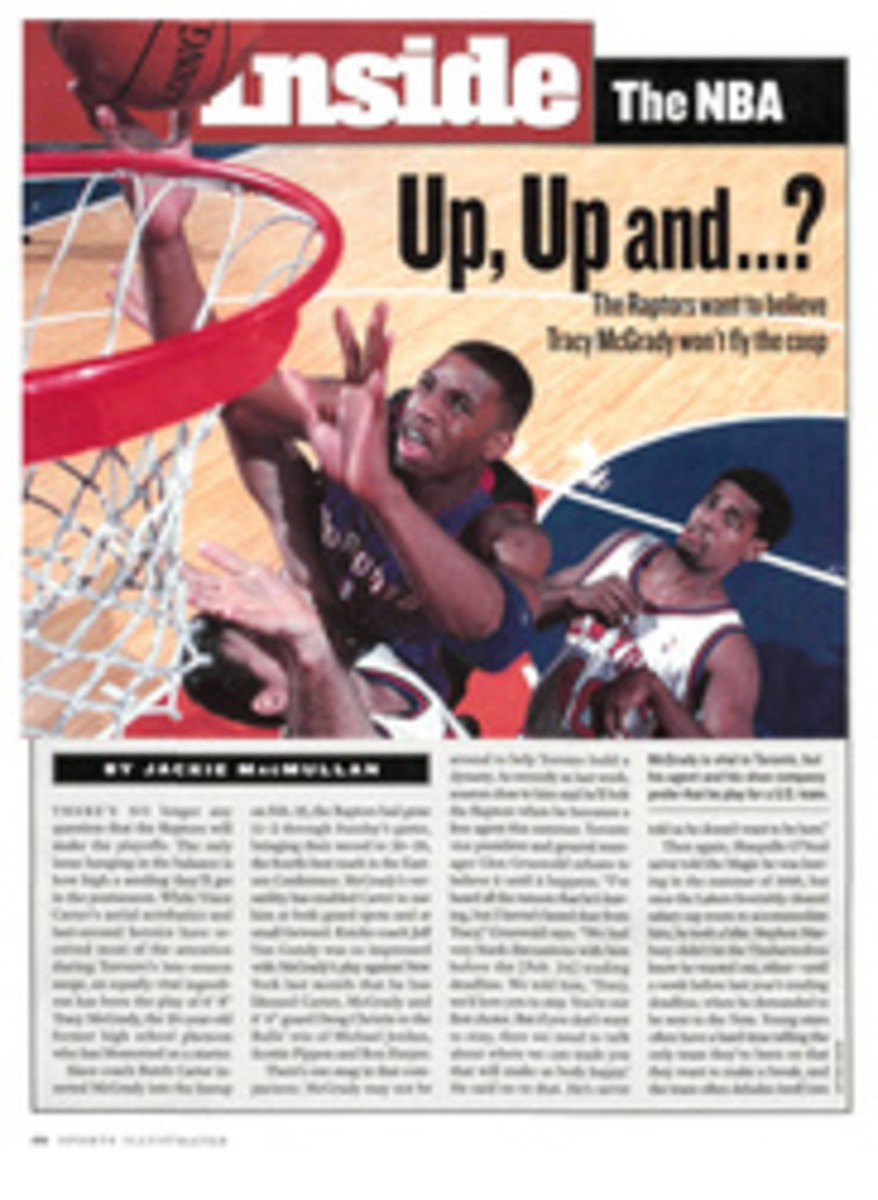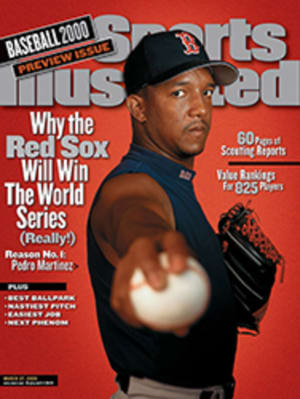
Question 3 What's the Nastiest Pitch in the Game? Because it plummets as it reaches the plate, the split-fingered fastball is as brutal on befuddled batters as on the elbows of pitchers who dare to throw it
Try this at home: Raise your hand as if hailing a taxi,
extending only the middle and index fingers. Now split those
fingers apart from each other, so they form a V. The ligaments
in your fingers tighten, the muscles in your forearm grow tense,
and the inside of your elbow may even feel slightly strained.
The more you spread your fingers, the more pronounced these
effects become. Now you know what it feels like to take your
baseball life in your hands.
The split-fingered fastball, which is thrown with the fingers in
the unnatural position mentioned above to make it dive savagely
as it reaches the batter, is "the toughest pitch to hit" in
baseball, according to no less an authority than Padres hitting
professor Tony Gwynn. It's a career-maker, but it's also a
career-breaker. Who wants to be a millionaire? When it comes to
the splitter, the answer is borderline big league pitchers and
orthopedic surgeons.
"There's a direct connection between the split-finger and
ligament strain on the medial side of the elbow," says one former
National League trainer who asked not to be identified. "It can
also cause tendinitis in the hands. There is no doubt it exacts a
tremendous toll and is a contributing factor in guys blowing out
[elbows]."
The split-fingered fastball has gained such a notorious
reputation that many organizations discourage their better
pitching prospects or anyone below the Double A level from using
it. For instance, when Astros righthanded prospect Tim Redding,
who has a 97-mph fastball, fiddled with a splitter during a
throwing session last year, a coach reacted as if Redding were
playing with a lit stick of dynamite. Redding was told never to
play with it again. Says one American League manager, "If I were
a pitcher, I'd find a way to cheat before I threw the splitter."
Such fearful thinking explains why the splitter, like Duran
Duran, is still out there but not nearly as popular as in its
glory days of the 1980s. "Facing guys with good splits, like
[Tigers righthander] Hideo Nomo, you can look for it and still
not hit it," says veteran Cubs first baseman Mark Grace. "That's
how tough it can be. But you don't see nearly as many as you did
10 years ago. Not even close. You know why? So many of those
guys who threw it eventually got operations." Adds Braves
shortstop Walt Weiss, "You rarely see the split anymore,
especially in the National League. It used to be the pitch. Now
it's the cutter. Everybody's trying to cut their fastball."
Then again, the splitter is the sole reason Red Sox reliever Rod
Beck is a multimillionaire. He was struggling in Class A with an
85-mph fastball when he picked up the pitch in 1988, a few weeks
before the A's traded him to the Giants. Three years later Beck
was called up by San Francisco, and he wound up the Giants'
career leader in saves. "Without the splitter," Beck says, "I'd
be pumping gas right now." Other active pitchers who have made
careers out of the splitter include closers Jeff Shaw of the
Dodgers and Dave Veres of the Cardinals, and Astros starter Shane
Reynolds.
"It was the turning point of my career," says the 6'3",
32-year-old Reynolds, who last season went 16-14 with a 3.85 ERA
for National League Central champion Houston. He picked up the
splitter late in 1991: "My pitching coach in Venezuela in winter
ball, Brent Strom, asked me if I wanted to spend one day in the
big leagues or 10 years in the minors. Then he said, 'This is
what you're going to do.' I don't think I would have made it
without the splitter."
Then there are pitchers such as Chuck Finley of the Indians and
Roger Clemens and David Cone of the Yankees who have enhanced
long, mostly healthy careers with the splitter. Clemens has
thrown a splitter since 1987, though he has used it more often
in recent years, he says, as the strike zone has dropped below
the belt. Cone, one of the foremost practitioners of the
splitter, has thrown 2,396 2/3 innings without elbow problems
since former big leaguer Diego Segui taught him the pitch in
winter ball in '86. "If thrown properly, it's no more taxing on
the arm than any other pitch," Cone says. "Dangerous? That's
ludicrous!"
Yet Cone's pitching coach, Mel Stottlemyre, says, "It can strain
the elbow. And I think it leads to losing velocity off your
fastball, especially if you fall in love with it."
Love hurts. The splitter has been a temptress ever since then
Cubs minor league pitching instructor Fred Martin taught it to
reliever Bruce Sutter in 1973. Stunned National League batters
hit .199 against Sutter over his first four seasons (1976 to
'79). Even though hitters knew the splitter was coming--Sutter
threw it 90% of the time--they couldn't hit it. "No one even knew
what it was," says former outfielder Merv Rettenmund, now the
Braves' hitting instructor. "It would look like a fastball right
above the knee, you'd go to swing, and then--boom!--it was gone. "
Roger Craig, a major league pitcher, pitching coach and manager
for 35 seasons, popularized Sutter's innovation in the 1980s. As
pitching coach of the Tigers, he turned the pedestrian Milt
Wilcox into a 17-game winner in '84; as informal tutor, he made
the Astros' Mike Scott, who had been 29-44 without the splitter,
into a Cy Young Award winner in '86; and, as manager, he guided
the '89 Giants to the National League pennant with a nondescript
rotation (Kelly Downs, Scott Garrelts, Mike LaCoss, Rick Reuschel
and Don Robinson).
The 1989 World Series was to the splitter what Woodstock was to
rock. Of the 15 pitchers used by Craig's Giants and Tony La
Russa's Athletics (whose pitching coach, Dave Duncan, also
promoted use of the pitch), 10 threw the splitter. Ten years
later, only six of the 18 pitchers used by the Yankees and
Braves in the World Series threw it. In the intervening years
Downs and Garrelts had their careers shortened by injuries,
while pitchers who avoided the pitch and relied on the changeup,
such as Atlanta's Greg Maddux and Tom Glavine and the Red Sox's
Pedro Martinez, had leaped to the fore.
Garrelts was finished in the big leagues at age 29 because of a
blown right elbow; he languished in the minors for four years
after undergoing Tommy John surgery. Reliever Bryan Harvey, who
in the late 1980s and early '90s relied heavily on one of the
game's nastiest splitters while racking up 177 saves for the
Angels and Marlins, also had his career cut short because of a
torn medial collateral ligament in his right arm. Earlier this
month, Atlanta's John Smoltz, who quit throwing his splitter in
the second half of last season because of right elbow pain,
suffered the same injury. Smoltz was scheduled to undergo Tommy
John surgery this week and is out for the season.
Now few starting pitchers besides Nomo use the splitter as their
feature pitch--and Nomo's loss of velocity on his fastball
(Stottlemyre's point) has added to the splitter's notoriety. The
pitch remains popular among relievers, who throw fewer pitches
and thus appear to be less at risk of injury from using the
splitter. Those starters who throw the splitter employ it
judiciously. Reynolds, for instance, goes to it only about 20% of
the time. "It's a finishing pitch in the right count against the
right hitters," says Duncan, now the pitching coach under La
Russa with the Cardinals, "and you use it enough [so] that
everybody knows you have it."
The split-fingered fastball is often confused with its close
cousin, the forkball. The latter is thrown with such a wide split
of the index and middle fingers that the ball comes off the
inside of the fingers. The grip imparts very little rotation on
the ball, which because of the lack of spin tends to tumble as it
nears the plate. The forkball is a pure off-speed pitch with the
velocity of a changeup.
The splitter is a fastball. It usually is thrown with the fingers
split just wide enough to be on the outside of two parallel
seams. It is treacherous for a hitter because it comes without
clues. "I throw it just like a fastball, and it has two-seam
fastball spin," Reynolds says, referring to a tight, fast,
underspin rotation. "The difference is you can't throw it as hard
as a fastball, and it has more downward action to it."
Clemens throws his splitter 10 to 15 mph slower than his
fastball, but hitters can't recognize it coming out of his hand
because with both pitches his wrist is square to the hitter.
With sliders and curveballs, in which a pitcher's fingers come
off the side of the ball rather than the top, a good hitter
sometimes can see the side of a turned wrist. "The splitter is
thrown with a fat wrist, not a thin wrist" is how Clemens
explains the pitch's appearance.
"It's actually thrown a lot more naturally than a curveball or
slider," Cone says. "The big thing Roger Craig [in informal
conversations] told me was to make sure you don't split your
fingers too wide. That's how a lot of pitchers get into trouble."
Even proponents of the pitch agree the splitter isn't for
everybody. To deliver it, a pitcher should throw over the top
rather than sling the ball sidearm or three-quarters. He also
needs long fingers. Cubs reliever Rick Aguilera conditioned his
fingers after the 1986 season by frequently wedging them around
a softball. Danger always looms: In '97 Cubs righthander Kevin
Tapani snapped a ligament in his right index finger. Doctors
told him it resulted from the strain of splitting his fingers
over the previous 13 years.
"We don't generally teach the splitter," says Dewey Robinson,
Houston's minor league pitching instructor, "but if a guy gets to
a point where he doesn't have the feel for a changeup or doesn't
have the aptitude to spin a curveball or a slider, then we'll
talk about it. Ask any Double A pitcher this: 'I'll give you the
chance to pitch five years in the big leagues, but with a high
probability of breaking down.' Would you take it? That's a
no-brainer."
The splitter, even in decline, remains too tempting for some
pitchers to resist--medial elbow ligaments be damned.
FOUR COLOR PHOTOS: CHUCK SOLOMON GETTING A HANDLE The grip on the split-fingered fastball (above) is akin to the one used for its cousin, the forkball (right)--though to a hitter the splitter looks like a two-seamed (far left) or cut (center) fastball, until it suddenly dips just before reaching the plate.
THREE COLOR PHOTOS: PHOTOGRAPHS BY DAVID E. KLUTHO NO CLUES The rangy Reynolds throws the splitter about 20% of the time, disguising it by using the same motion as he employs for his conventional fastball.
COLOR PHOTO: TOM DIPACE SPLIT DECISION Some scouts think Nomo (here flinging a forkball) may have lost zip on his fastball by overusing the splitter.
To deliver a splitter, a pitcher needs to throw over the top
rather than sling the ball sidearm or three quarters.
If thrown properly, it's no more taxing on the arm than any other
pitch," says Cone. "Dangerous? That's ludicrous!"

